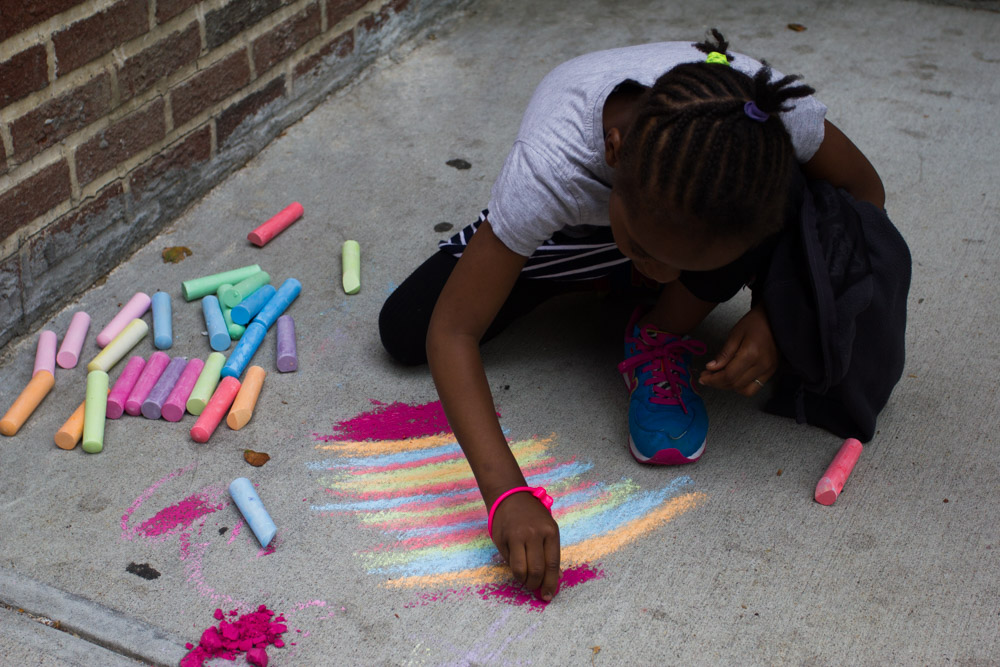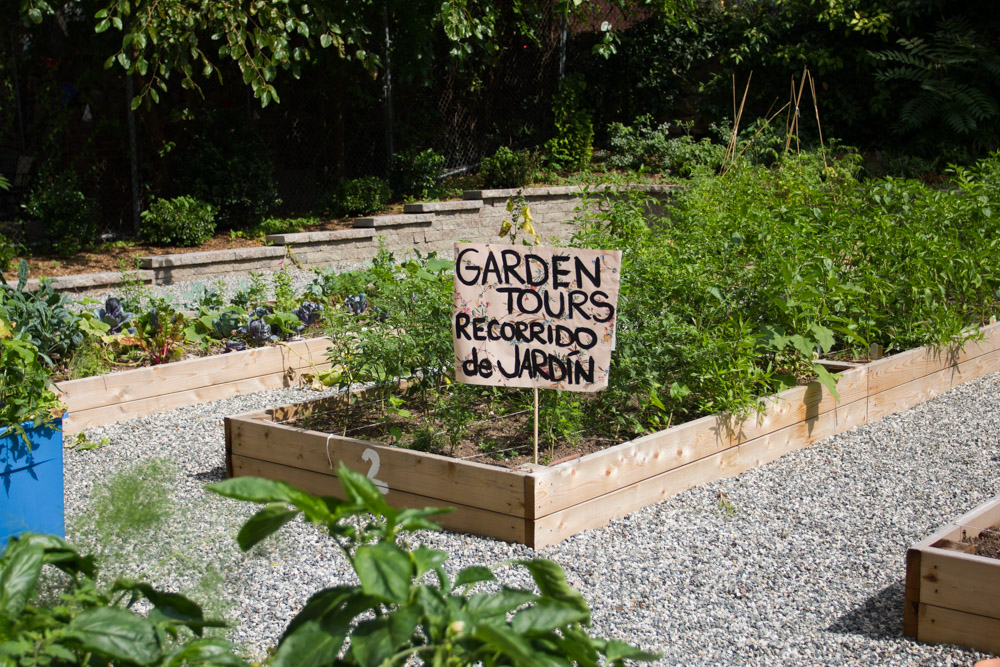
A child draws on the pavement with colored chalk outside Block 924. SAHELI ROY CHOUDHURY / The Bronx Ink
On Saturday morning in Hunts Point, children on Kelly Street had free rein of the pavement, which some of them brightened with colored chalk. Some kids played catch while others were engrossed in arts and crafts. With the help of adult volunteers, children cut out bananas from cardboard and painted them, some coloring them yellow, others maroon and sky blue. Residents from neighboring blocks looked on. They had gathered at the newly renovated Kelly Street Garden at block 924 of the famously banana-shaped street to celebrate the second annual Field Day organized by the non-profit outfit, The Laundromat Project.
The star of the event was the Kelly Street Garden, which has become a symbol of revival to a community that had lost its vibrancy through time and neglect. It was unveiled in the first week of June this year. On Saturday, the garden opened its gates to residents in neighboring buildings, some of whom help to tend its 1,541 square feet of harvest area that grows cucumbers, tomatoes, salad greens, kale, and eggplant, among other produce that helps sustain the community.
Field Day at Hunts Point aimed to encourage community involvement through art and yoga workshops, cooking demonstrations, a photo exhibition, storytelling sessions, a barbecue, and walking tours led by local artists Misra Walker and Joseph “Donjai” Gilmore. Walker and Gilmore’s walking tours explored the rich cultural history of the neighborhood by focusing on creative practices of local artists throughout the community.
This arts-led initiative took place concurrently in three neighborhoods — Hunts Point, Harlem, and Bedford-Stuyvesant on September 20 and 21. “We wanted to highlight the assets that are already in these neighborhoods, and to amplify them as much as possible,” said Kemi Ilesanmi, the executive director of the Laundromat Project.

On the itinerary was a Kelly Street Garden tour. The garden grows approximately 20 types of produce, including cucumbers, tomatoes, salad greens, kale and eggplant. SAHELI ROY CHOUDHURY / The Bronx Ink
Long-time Kelly Street resident Robert Foster, 63, said the garden was a “‘great way to bring the community back together.” He lamented how closed off neighbors have become, preferring to stay indoors instead of interacting.
Foster was around in the late 1970s when the first garden was inaugurated in block 924, where he helped plant the first batch of seeds. “It ain’t as luxurious,” he said of the old garden, but the spirit of community thrived due to the large presence of children. “You couldn’t throw a rock without hitting a kid,” he said, smiling. Over the years, the conditions of the houses deteriorated, the streets became unsafe as murders and drug activities rose, and the children disappeared behind closed doors. “I can’t fault people for not wanting to have their kids out there,” Foster said, hoping the newly renovated buildings will signal a safer environment for children to come out and play.
The kids were out in full force on Saturday, running around the raised beds on the pebbled pathway, only to be told repeatedly by Rosalba Lopez Ramirez, the garden caretaker, not to stomp on the plants. Ramirez moved to the neighborhood last December and as caretaker she holds regular office hours tending the the garden. Since its opening, the garden “picked up a lot of momentum,” she said, as a new wave of residents followed in Foster’s footsteps and helped out with maintenance.
Until three years ago, Ramirez said many of the buildings on Kelly Street suffered from dire neglect, and the garden lay forgotten. Then Workforce Housing Group intervened. The group, in partnership with Banana Kelly Community Improvement Organization, another non-profit outfit, rehabilitated apartments in five buildings on Kelly Street. With a grant from the Department of Environmental Protection, the two organizations were able to fund the purchase of plants, seeds, and fertilizer for the new garden.
Another long-time resident, who gave only her first name, Maria, 45, spoke in Spanish about the dire living conditions prior to the intervention by the Workforce Housing Group. Speaking through a translator, Maria said her building lacked hot water every winter between 2001 and 2011; many of the buildings did not have a superintendent to look after maintenance. There were severe hygiene issues, she added, rat infestations, and lack of security. All complaints by residents fell on deaf ears. Today, Maria is satisfied with her renovated apartment. It now has a constant supply of hot water, the staircase landings are clean, the building is regularly maintained, and the security is much better.
Ramirez said the garden provides valuable community bonding time as residents now work together to water the plants, harvest the produce, and distribute it through the neighborhood. Residents who volunteer their time to look after the garden get first pick of the produce. Some of it is used in cooking classes taught by “community chefs” at the garden to encourage an exchange of healthy recipes. Ramirez also sets up a table on the pavement in the evening and gives away the remaining produce to passersby for free.

The community gathered outside 924 Kelly Street to celebrate Field Day. Activities included arts and crafts for children, yoga workshops for children and adults, and a barbecue. SAHELI ROY CHOUDHURY / The Bronx Ink
Field Day was organized by five artists who were recipients of a fellowship at The Laundromat Project and wanted to give back to the community. Through the fellowship, they took a number of professional development classes in community engagement and were assigned to a neighborhood in which to execute an outreach program.
One of the fellows, Ro Garrido, 25, said the experience helped overcome the discomfort of working in a community in a different borough. “I don’t have roots here,” Garrido, who hails from Queens, said about the experience in negotiating the differences between Hunts Point and Jackson Heights. “It’s about respecting the people at the garden and how they worked.”
The fellows received $500 from the Laundromat Project, as well as donations from Green Mountain Energy, Workforce Housing Group, and others to purchase art supplies, arrange for food, and other logistics. Though Field Day organizers did not have a final headcount by press time, they said they expected the number of participants among the three neighborhood events in Hunts Point, Harlem, and Bed-Stuy, to exceed last year’s 500.
As the overcast afternoon gradually faded into evening, the echoes of children’s laughter reverberated along Kelly Street. Residents stayed out longer than usual, embracing a new-found communal spirit.
